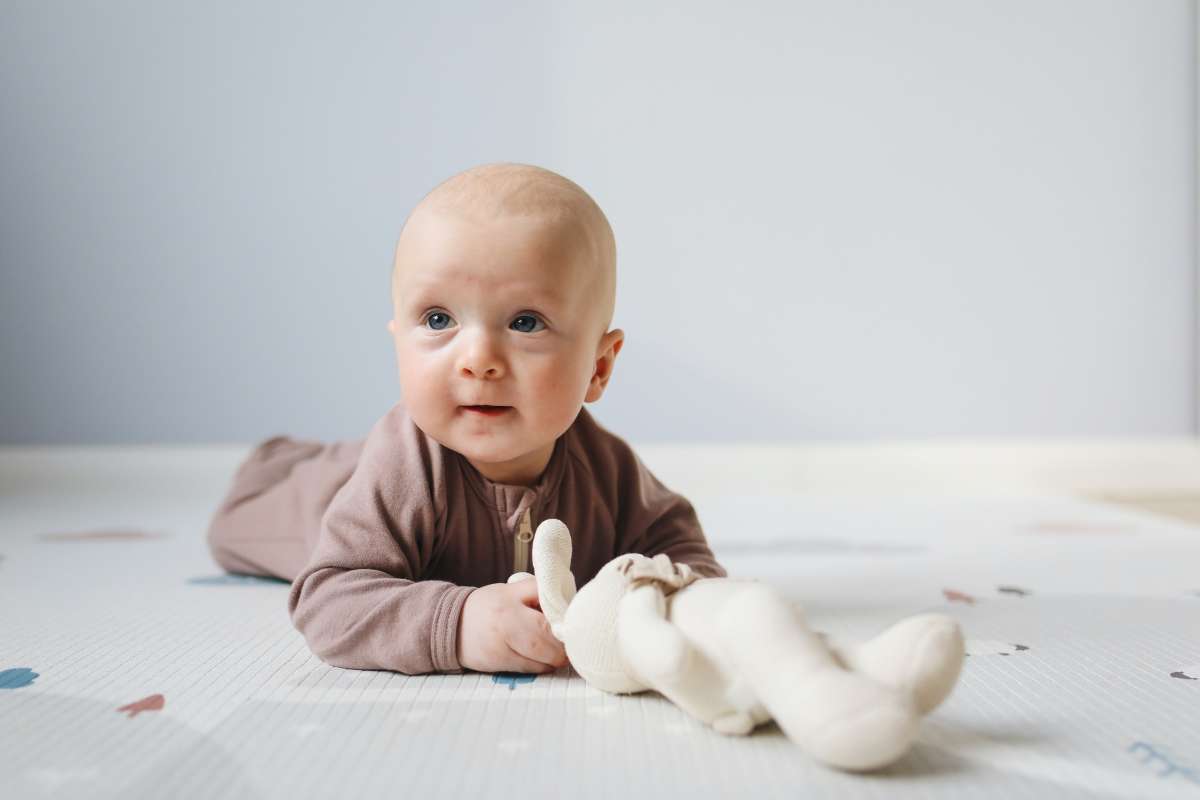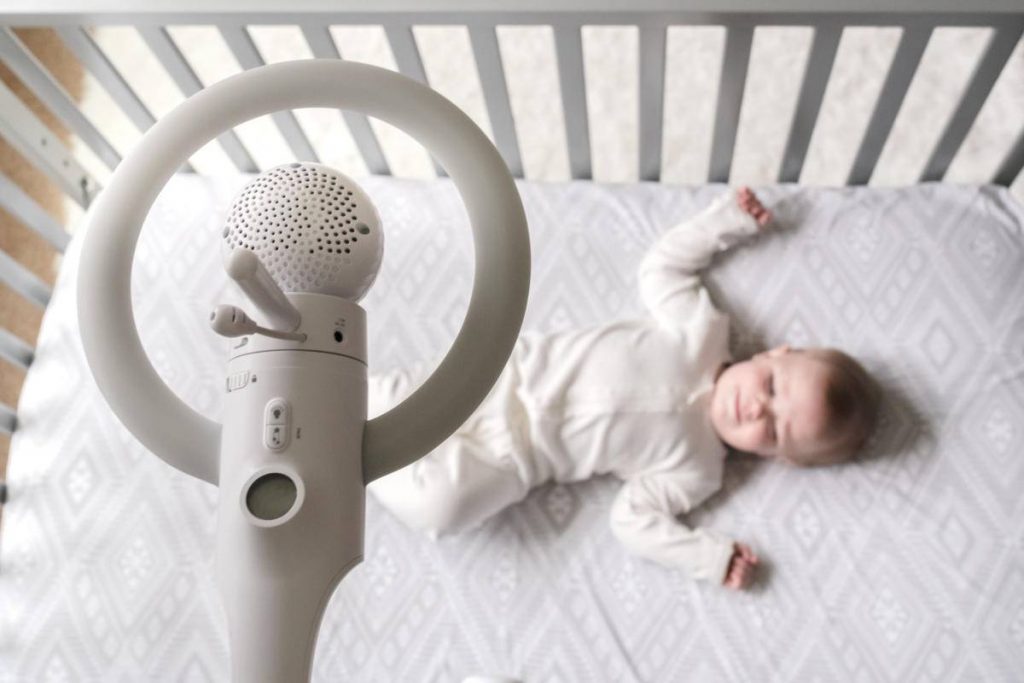Everyone really understands how much you're looking forward to celebrating your child's firsts. The same goes for turning over in their crib.
However, please keep in mind that each and every baby is unique. This implies that your baby's first time rolling over in the crib might not occur at the time you anticipate.
Between the ages of four and six months, it is common for newborns to begin rolling over in their cribs. It's possible for them to roll onto their side, stomach (the most common position), or back and forth. They should be proud of themselves no matter what they achieve.
If they want to start crawling and walking, one of the first things they need to do is learn how to roll over in their crib without assistance.
Please don't turn your baby over when you see them rolling over from their back to their belly. Rolling from back to tummy is a natural movement, so turning around the opposite way shouldn't be too much of a challenge.
While most parents eagerly anticipate their child's ability to roll over from their stomach to their back, there's no rule that says the opposite can't happen first.
Most infants master the ability to roll over from their back to their belly by the time they are seven months old, and soon after that they master the ability to roll over to their side.
FAQs About Baby
Babies usually learn how to roll over between four and seven months old. When practising tummy time, your baby begins strengthening the muscles in their core, arms, and neck. As they experiment with movement, they will learn how to roll from front to back and back to front.
You may go in to check on your baby and realise they have rolled onto their side or stomach in their crib. You do not need to move your sleeping baby from another position to their back in this case. It is important to always lay your baby down to sleep on their back, but if they move on their own, that is okay.
Once your baby can roll independently, you can rest assured that they have the strength and development to move if their airway is obstructed. However, it is still important to ensure there are no suffocation or choking hazards in your baby’s crib. This includes:
- Blankets and quilts
- Pillows
- Comforters
- Toys
- Bumper pads
Remember that professionals also recommend against sleep positioners or support pillows.
Much like a baby that gets stuck on their stomach, because this phase usually only lasts for a few weeks, the simplest solution may be to flip your baby back onto their back and use a pacifier or some shushing noises to help them fall back to sleep.
No. Rolling over is an important and natural part of your baby's growth. Most babies start rolling over on their own around 4 to 6 months of age. If your baby rolls over on its own during sleep, you do not need to turn the baby back over onto its back.
For this technique, you put the baby down in their usual position (back for a back sleeper, tummy for a tummy sleeper) and leave. If they roll over, you flip them back one time only. After that, it is up to them to either roll back or falls asleep in the new position.
What Should You Do If Your Baby Rolls Over In Their Crib?

What should you do if you peek into your baby's crib and see them lying on their bellies for the first time?
Don’t Panic!
There is no need to panic if you wake up to find your infant has rolled over in the middle of the night. Changing positions when snuggled up and sleeping is quite typical for your little one.
There is no reason to panic the first time you see your baby sleeping on their tummy in their cot, though you should take some safety precautions.
Stop Swaddling Your Child Prior To Bedding
Although swaddling is effective at making your baby feel calm and at ease, you should avoid doing so.
Your baby's freedom of movement may be compromised if you keep their arms bound to their sides as they sleep. They won't swaddle their baby if they need to move them away from the mattress. They must not become trapped!
Swaddling may help your baby feel safe and secure, but a sleep bag with armholes is a good alternative if your little one prefers to be able to move around. This manner, they can sleep well knowing their arms are warmly encased in a blanket without restricting their mobility.
Keep Your Sleep Space Clutter-Free
Baby nurseries crammed with decorative cushions, blankets, and plush animals may look cute in pictures, but they aren't conducive to a good night's sleep.
Your baby's safety is your top priority, so keep soft toys like the stuffed elephant she adores outside of the crib.
You can lessen the likelihood of SIDS by providing an uncluttered, open environment for your baby's sleep (SIDS). You can greatly reduce the odds of something blocking your baby's airways while they sleep if you remove all supplementary items from the cot.
When kids flop over on their mattress, face first, it's important that they have clean, well-fitting sheets and a fresh, airy pillowcase to rest their heads on.
If you're looking for a safe, chemical-free crib sheet that will keep your baby warm all night long while allowing them to breathe comfortably, go no further than our organic, breathable Cotton Sheets!
Use A Crib Instead Of A Cradle
We don't want your baby's bed to move around while he or she tosses and turns throughout the night.
If the rocking action of a cradle helps your infant fall asleep, it might be a beautiful addition to your child's nursery. When it comes to the safety of a baby rolling over in their sleep, a cradle may be a little less secure than a standard crib or bassinet.
Cribs are well-made and can support your active infant even as it grows. They will give your child ample back and belly support to prevent them from toppling over in their sleep!
No matter what developmental stage your baby is at, you can be assured that they will always be comfortable and safe on our crib mattress. It's built to last through the toddler years, giving your child the comfortable sleep they need to develop both mentally and physically.
Always Place Your Baby On Their Back To Sleep.
When putting a baby to sleep, the National Institute of Health advises that they be placed on their backs in a crib. This greatly reduces the possibility of sudden infant death syndrome, particularly in the first year of life.
It's natural to worry, "What if You wake up in the middle of the night to find the kid sleeping on their stomach?" We are not sure whether or not to flip them back.
The correct response is "no." It is fine if your baby rolls over during the night as long as they go to sleep on their back. Getting from their bellies to their backs is much simpler, so they can be expected to do so if they decide to.
It's common knowledge that waking a sleeping baby goes against the cardinal rule of dealing with infants: don't do it unless you really have to!
Managing Your Baby's Rolling Over At Night

A parent's instincts may be tested when their infant rolls over in the middle of the night. It's normal to be anxious about the future when you have a newborn. Some developmental milestones, like rolling over, may cause you anxiety.
When babies learn to roll over, usually between four and six months of age, they may begin rolling onto their stomachs throughout the night.
So, you may sleep soundly without worrying about them turning over in their sleep. However, it is still best practise to place your baby on their back to sleep in order to reduce the risk of SIDS.
Bedtime Routine Handling Roll Over
You should always put a newborn to sleep on his or her back. Babies should spend the first year of their lives sleeping on their backs. It is best to put your infant to sleep on his or her back, even though he or she may roll over during the night. Infants who are placed on their backs to sleep have a lower risk of SIDS.
- Make an effort to raise only one arm. You can prevent them from rolling onto their belly by extending an arm. They will be less likely to end up on their stomachs if you do this.
Put your baby down on their back instead of their stomach or side. Don't put your infant to sleep on his or her side or stomach at night. When a baby is placed to sleep on their side or stomach, it increases the likelihood that they will have SIDS.
Putting a newborn to sleep in these positions increases the risk of suffocation or smothering since they cannot move freely in their sleep and do not yet have the strength in their neck and head to support themselves.
Get your sleeping space in order. Make sure the crib has a firm mattress covered with a fitted sheet, and never leave anything in there. Remove any clutter from the crib, including toys, blankets, cushions, etc., before fitting the sheet to the mattress. Avoid using a sleep positioner as well.
- Sheets that are too big or too tiny for the mattress might cause suffocation or entanglement, both of which can disrupt your baby's sleep.
- Your infant should be the only thing in the crib when it's time for bed. This safety measure is one way to lessen the possibility of SIDS in infants.
- To keep your infant on their back when they sleep, you shouldn't use a sleep positioner. The risk of suffocation is raised when using a sleep positioner. The use of a sleep positioner is not supported by scientific evidence, thus getting rid of yours is a good idea.
Do not put too much stock in baby monitors. The baby's respiration, heart rate, and sleeping position may all be monitored remotely from the convenience of your smartphone. Still, they have not been shown to prevent SIDS.
Keep your baby on their back to sleep, remove all loose bedding, use a fitted sheet, and avoid soft bedding—these are all tried-and-true methods for lowering the risk of SIDS.
Make time to unwind and relax. Once your baby is asleep, you may find some relief from your worries by practising some relaxation techniques. Relax by taking some deep breaths, soaking in a tub filled with Epsom salts, or stretching out before bed.
- When you have muscle soreness, an Epsom salt bath is a great way to relax and ease the pain.
- Relax your neck and shoulders with a simple shoulder shrug. Raise your shoulders up to your ears and hold for a few seconds; then, relax and return them to their normal position. Before going to sleep, try this stretch a few more times.
Roll Over Strength Assessment
Consult your doctor. Your doctor should be consulted on your child's growth. It might be worth your time to ask them some questions about rollover if you decide to:
- Do you believe my infant is strong enough to roll over securely at night?
- When will my kid be able to roll over in the middle of the day?
- Should I be concerned about my kid rolling over in the middle of the night?
- What can I do to avoid Sudden Infant Death Syndrome (SIDS)?
Determine if your infant can roll onto their stomach. Your baby should be able to roll over at night if they can do so during the day while being watched.
Baby can roll over at night without waking you if he or she is strong enough to accomplish it during the day. Even though it's best to have them sleep on their back, if they roll over throughout the night, you shouldn't panic.
- About six months of age is when most babies can learn to roll over.
Check to see if they are able to roll over onto their back. Keep an eye on your infant while they play on their tummy throughout the day. Check to see whether they can successfully perform a belly-to-back roll while playing.
It is not necessary for you to be concerned about your child turning onto their stomach while sleeping if they are able to rock back and forth with sufficient strength to safely roll back onto their back. They should be able to roll over onto their backs if they try.
Check the strength of the head and neck. If your infant can hold their head up and roll over, they should be able to handle rolling over in the middle of the night as well. Even though it's best to have them sleep on their back, if they roll over throughout the night it's not cause for alarm.
- They can gain muscle by spending time on their bellies throughout the day under supervision. Spending time on their bellies helps them build up the muscle tone in their neck, chest, and arms, which in turn makes it easier for them to keep their head up.
- At one month, most babies can support their head for a few seconds while belly-down.
- The average infant can lift their head 45 degrees by the time they are two months old.
- When your baby is four months old, they should be able to keep their head up at a ninety-degree angle.
Night-Time Response To Your Baby
Make the ask of your companion. You might want to try asking your partner for assistance with the infant. They can assist you in getting some rest by responding to the infant at least occasionally. There are times when they may even put the infant to sleep. Think About Inquiring:
- Can you reply to the infant when they wake up the next time?
- Can you please put the baby to sleep next time?
Find out if they have managed to turn over on their own. The danger of SIDS is highest between the ages of one and four months, when babies often still can't roll over on their own.
They might accidentally roll onto their bellies if they were put to sleep on their sides before they had the muscle control to fully roll over. It's also possible that they're lying face down for reasons than those already mentioned.
Positioning an infant on his or her back is indicated to reduce the risk of SIDS.
- Keep in mind that this problem can be avoided by always having them sleep on their back.
You can chill out if they have enough strength to roll over. Babies typically begin rolling over onto their stomachs in their sleep at roughly the same time they begin doing so during the day, around the fourth or fifth month mark.
If your infant is strong enough to turn over and keep their head up, they will be able to self-adjust in their sleep. Don't worry about it; just let them settle into a restful position on their own.
Go back to sleep. Do not fret over your baby turning over in their sleep if they have the physical ability to roll over onto their stomach and back. They have likely passed the most dangerous stage for SIDS if they are rolling over in their sleep.
The baby can turn back onto their back if they roll onto their stomach, so there's no need to wake up every time they do it. Stop worrying and try to get some more shut-eye.
Additional Sleep Safety Concerns
Use footie pyjamas if you're worried your infant will feel cold at night. Swaddling helps infants feel safe and cosy while also keeping them toasty warm, which is why many parents resort to this practise. Even after your baby learns to roll over on their own, you can continue to swaddle them safely.
As soon as your baby shows signs of being able to roll over, you should cease swaddling them so they have the freedom to move into a position that won't obstruct their airway. Baby's face shouldn't be covered by the swaddle, so make sure it fits snugly and has no extra fabric.
Make sure there is a secure sleeping environment for your infant whether they spend the night with grandparents, other relatives, or friends. Have a conversation with them about healthy sleep practises, such as placing your newborn on their back to sleep, to increase the likelihood that they will implement this for you. The rules should be followed not just at night but also during naps.
Conclusion
Babies typically start rolling over in their cribs between four and six months. By the time most babies are seven months old, they have mastered rolling over from their back to their belly. Your baby sleeping on their tummy in their crib is very normal. Sturdy construction means cribs can keep up with your active child as it ages. They will keep your kid from rolling over when they sleep by providing adequate support for their back and bellies.
Remove any pillows, blankets, or toys from the crib to lower the risk of suffocation for your infant. To worry about what the future holds is natural for new parents. Feeling nervous about certain developmental milestones, including learning to roll over, is normal. However, infants should only sleep on their backs within the first year of life. Infants whose sleep position is on their backs are less likely to develop sudden infant death syndrome.
Babies should always sleep on their backs on a firm, flat surface with a fitted sheet and no loose blankets or pillows. If your infant can roll over while watching during the day, they should be able to do so when you're asleep. Always keep a close check on your baby when they are playing on their tummy. Find out if they can do a successful backwards roll from lying on their stomach. By the time they are two months old, most babies can incline their heads 45 degrees.
Babies that can roll over while sleeping has likely passed the most difficult period for sudden infant death syndrome. Babies benefit from being swaddled because it makes them feel secure and cosy while keeping them warm. Whether your baby spends the night with grandparents, other relatives, or friends, you should make sure they have a safe place to sleep.
Content Summary
- Everyone understands how much you look forward to celebrating your child's firsts.
- This implies that your baby's first time rolling over in the crib might not occur at the time you anticipate.
- If they want to start crawling and walking, one of the first things they need to do is learn how to roll over in their crib without assistance.
- Please don't turn your baby over when you see them rolling over from their back to their belly.
- Rolling from back to tummy is a natural movement, so turning around the opposite way should be easy.
- Most infants master the ability to roll over from their back to their belly by the time they are seven months old, and soon after that, and they master the ability to roll over to their side.
- There is no need to panic if you wake up to find your infant has rolled over in the middle of the night.
- There is no reason to panic the first time you see your baby sleeping on their tummy in their cot, though you should take some safety precautions.
- This way, they can sleep well, knowing their arms are warmly encased in a blanket without restricting their mobility.
- Your baby's safety is your top priority, so keep soft toys like the stuffed elephant she adores outside the crib.
- You can lessen the likelihood of SIDS by providing an uncluttered, open environment for your baby's sleep (SIDS).
- If you remove all supplementary items from the cot, you can greatly reduce the odds of something blocking your baby's airways while they sleep.
- If the rocking action of a cradle helps your infant fall asleep, it might be a beautiful addition to your child's nursery.
- When it comes to the safety of a baby rolling over in their sleep, a cradle may be less secure than a standard crib or bassinet.
- No matter your baby's developmental stage, you can be assured that they will always be comfortable and safe on our crib mattress.
- When putting a baby to sleep, the National Institute of Health advises that they be placed on their backs in a crib.
- It is fine if your baby rolls over during the night as long as they go to sleep on their back.
- However, it is still best to practise placing your baby on their back to sleep to reduce the risk of SIDS.
- It would be best if you always put a newborn to sleep on its back.
- It is best to put your infant to sleep on their back, even though they may roll over at night.
- Infants placed on their backs to sleep have a lower risk of SIDS.
- Put your baby down on their back instead of their stomach or side.
- Please don't put your infant to sleep on their side or stomach at night.
- When a baby is placed to sleep on their side or stomach, it increases the likelihood that they will have SIDS.
- Your infant should be the only thing in the crib when the bed is time.
- It would be best if you didn't use a sleep positioner to keep your infant on their back when they sleep.
- The risk of suffocation is raised when using a sleep positioner.
- Once your baby is asleep, you may find some relief from your worries by practising some relaxation techniques.
- Baby can roll over at night without waking you if they are strong enough to accomplish it during the day.
- Keep an eye on your infant while they play on their tummy throughout the day.
- Check to see whether they can successfully perform a belly-to-back roll while playing.
- It is not necessary for you to be concerned about your child turning onto their stomach while sleeping if they or can rock back and forth with sufficient strength to roll back onto their back safely.
- If your infant can hold their head up and roll over, they should also be able to handle rolling over in the middle of the night.
- Even though it's best to have them sleep on their back, if they roll over throughout the night, it does not cause alarm.
- They can gain muscle by working on their bellies throughout the day under supervision.
- Try asking your partner for assistance with the infant.
- Positioning an infant on their back is indicated to reduce the risk of SIDS.
- Babies typically begin rolling over onto their stomachs in their sleep roughly the same time they begin doing so during the day, around the fourth or fifth-month mark.
- If your infant is strong enough to turn over and keep their head up, they can self-adjust in their sleep.
- Do not fret over your baby turning over in their sleep if they can roll over onto their stomach and back.
- They have likely passed the most dangerous stage for SIDS if they are rolling over in their sleep.
- Use footie pyjamas if you're worried your infant will feel cold at night.
- Even after your baby learns to roll over on their own, you can continue to swaddle them safely.
- Ensure a secure sleeping environment for your infant, whether they spend the night with grandparents, relatives, or friends.
- Have a conversation with them about healthy sleep practises, such as placing your newborn on their back to sleep, to increase the likelihood that they will implement this for you.






